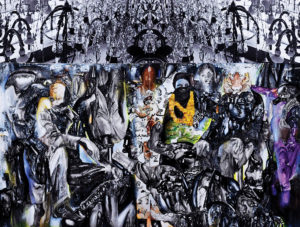At the ongoing exhibition titled ‘Family is Plural’, artist Probir Gupta explores the idea of archiving memory and his work is constructed from diverse experiences – often those of suffering and resistance
Urban politics, migration, humanity and communities – for Kolkata based artist Probir Gupta, the politics of citizen protest and activism are naturally part of his cultural ethos, which visibly finds expression in his work as well.
His recent works are on display at the ongoing exhibition titled ‘Family is Plural’ presented by Anant Art. As the title of the show suggests, Gupta’s work is constructed from diverse experiences – often those of suffering and resistance.

Layered with activism and political overtones, the artworks explore the idea of archiving memory, which is repeatedly being presented as the point of intersection of the personal, political and historical.
Gupta believes that his art must speak of politics, and the visual is a language of protest. “Visual arts are my medium today. If I was not a visual artist, I would have been a filmmaker, a writer or a songwriter. For me, above everything is humanity. I don’t like any human being to be hurt, discriminated against or to lose her or his democratic rights,” says Gupta.
Marked with contemporary relevance, the artist gives the socio-political events an artistic spin. For instance, one of his works – “The Indian Tempest”, uses both photography and painting to build upon citizen mass movements that marked the Arab Spring earlier this decade, and later came to unify India in collective anguish after the 2012 Nirbhaya gang rape case. The 9/12 feet work has a theatrical element to it, with images of a gas mask, a child being trodden upon and various inverted and headless figures that complicate the piece.
Another equally though provoking work – “Indian Boat” made using political posters, rubber stamps and a magnified helmet covering a headless child, offers a critique of militarism and bureaucracy and makes a powerful statement about oppression and control.
“His engagement is straightforward, with narratives of political struggle, activism and historical unfolding. The exhibition promises a visually exciting and thought-stimulating experience,” says Mamta Singhania, Director of Anant Art.
The artist’s paintings and photos are mostly in black and white, which is representative of a reality that is not fantastic, but always has content, situations and people rooted in our world. With each work densely charged with relevance, it provides ample space for interpretation by the individual viewer.
The exhibition is on display at Bikaner House till December 29





